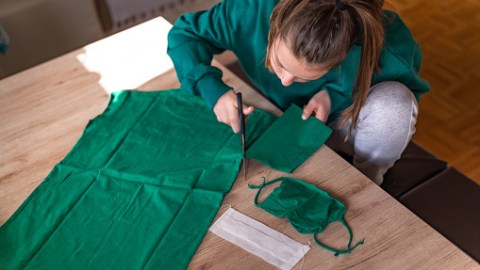Scientists find the best DIY face mask design and materials

Photo Credit: ti-ja / Getty Image
- Researchers found that combining two materials in a “hybrid” mask is the best alternative method to stop the spread of coronavirus.
- The filtration efficiency of the hybrid materials such as cotton-silk, cotton-chiffon, and cotton-flannel was greater than 80 percent for particles less than 1000 nanometers.
- The most important thing is to ensure that your mask fits properly and that you wear it correctly.
Though there is some debate, most medical experts agree that wearing a mask in public to stop the spread of COVID-19 is better than doing nothing.
As to what kind of design is most effective, research published in ACS Nano found that combining two materials is the best method to stop the spread of infection. But the fit must be right.
Materials tested
Because surgical and N95 masks are scarce and should be reserved for medical professionals only, you should be either purchasing or making cloth facial coverings.
Researchers from Argonne National Laboratory and the University of Chicago in the United States tested which materials were the most effective at filtering out germ ridden particles. They took a variety of common materials including cotton, silk, chiffon, flannel, various synthetics, and combinations of each to investigate the mechanical and electrostatic filtration properties in lab conditions.
The scientists found that mixing a variety of fabrics and applying multiple layers was the best way to filter out particles. However, it is essential that the mask fits properly or else the entire contraption is a bust.
“Overall, we find that combinations of various commonly available fabrics used in cloth masks can potentially provide significant protection against the transmission of aerosol particles,” explain the researchers in their paper.

Fig. 1- Schematic of the experimental setup. A polydisperse NaCl aerosol is introduced into the mixing chamber, where it is mixed and passed through the material being tested (“test specimen”)
Abhiteja Konda et. al.
Experimental design
To conduct this test, the researchers sampled the number of aerosol particles in the air by using an aerosol mixing chamber. Next, they filtered the particles through each of the test fabrics, which were secured on the end of a PVC tube. They then sampled the air that made it through that material.
The particle sizes in the experiment varied wildly, from about 10 nanometers up to 10 micrometers. (One micrometer equals 1000 nanometers.) Coronavirus particles range between 80 and 120 nanometers in diameter.
The particles tested were small, and we don’t yet know if those little aerosolized particles can cause disease. However, materials that can filter out even the smallest of particles are the best bet to ensure that the larger particles, more likely to carry infection, will be denied entry.

Hybrid masks are best
The team found that layering multiple materials (‘hybrid’ fabrics) was the best approach to filtering out a majority of particles.
The filtration efficiency of the hybrid materials such as cotton-silk, cotton-chiffon, and cotton-flannel was greater than 80 percent for particles less than 1000 nanometers. It was greater than 90 percent for particles greater than 300 nanometers. Simply put, those combinations were very effective at keeping particles from transmitting.
“We speculate that the enhanced performance of the hybrids is likely due to the combined effect of mechanical and electrostatic-based filtration,” noted the researchers.
The team found that fabrics like cotton, which has a high thread count, work the best at catching particles (called ‘mechanical filtration’). Smaller gaps mean that fewer big particles can shimmy through.
“Electrostatic-based filtration is a little different,” reports Science News. “Think of a super static-y material such as polyester. Instead of zapping a friend with all the static electricity you saved up, the electrostatic filter keeps the aerosols inside the static environment.”
A proper mask fit is essential
But the most important thing is to ensure that your mask fits properly, and that you wear in correctly. In the second part of the experiment the team poked tiny holes in the fabrics they were experimenting on, and the results were alarming.
“Our studies also imply that gaps (as caused by an improper fit of the mask) can result in over a 60 percent decrease in the filtration efficiency,” the researchers explained.
You can make a hybrid material mask using several online resources. Or, if you just want to make an old school mono-material mask, that’s better than nothing. The CDC has a guide here.






